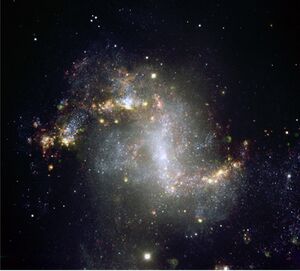Astronomy:NGC 1313
| NGC 1313 | |
|---|---|
 A Very Large Telescope (VLT) image of NGC 1313. Credit: ESO. | |
| Observation data (J2000.0 epoch) | |
| Constellation | Reticulum |
| Right ascension | 03h 18m 15.4s [1] |
| Declination | −66° 29′ 50″ [1] |
| Redshift | 0.001568 [1] |
| Distance | 12.886 Mly[1] |
| Characteristics | |
| Type | SB(s)d[1] |
| Apparent size (V) | 9.1 x 7.1 arcmin[1] |
| Other designations | |
| Topsy Turvy Galaxy, PGC 12286, ESO 082- G 011 | |
NGC 1313 (also known as the Topsy Turvy Galaxy[2]) is a field galaxy[3] and a irregular galaxy[4] discovered by the Scottish astronomer James Dunlop on 27 September 1826.[5] It has a diameter of about 50,000 light-years, or about half the size of the Milky Way.[6]
NGC 1313 lies within the Virgo Supercluster.[7]
In 2007, a rare WO star was discovered in NGC 1313,[8] currently known by its only designation of [HC2007] 31. It is of spectral type WO3.[8] The derived absolute magnitude is about -5,[8] which is very high for a single WO star. (WOs usually have absolute magnitudes of about -1 to -4) This means that the WO is likely part of a binary or a small stellar association.[8]
Two supernovae have been observed in NGC 2841: SN 1962M (type II, mag. 11.7),[9] and SN 1978K (type II, mag. 16).[10]
Features
NGC 1313 has a strikingly uneven shape and its axis of rotation is not exactly in its centre.[11] NGC 1313 also shows strong starburst activity[12] and associated supershells.[13] NGC 1313 is dominated by scattered patches of intense star formation, which gives the galaxy a rather ragged appearance.[14] The uneven shape, the ragged appearance and the strong starburst can all be explained by a galactic collision in the past.[15] However, NGC 1313 seems to be an isolated galaxy and has no direct neighbours. Therefore, it is not clear whether it has swallowed a small companion in its past.[2]
Young, blue stars are scattered across the galaxy.[16] This is evidence of infant mortality in which the young open clusters quickly became gravitationally "unglued", scattering their resident stars into the galaxy.[17] The galaxy bears some resemblance to the Magellanic Clouds[18] and hosts two ultraluminous X-ray sources, called NGC 1313 X-1 and X-2.[19] The former is a rare intermediate-mass black hole.[20][21]
References
- ↑ 1.0 1.1 1.2 1.3 1.4 1.5 "NASA/IPAC Extragalactic Database". Results for NGC 1313. https://ned.ipac.caltech.edu/byname?objname=NGC1313&hconst=67.8&omegam=0.308&omegav=0.692&wmap=4&corr_z=1.
- ↑ 2.0 2.1 "The Topsy-Turvy Galaxy NGC 1313". ESO. 23 November 2006. https://www.eso.org/public/images/eso0643a/.
- ↑ "Taking a narrow view of lopsided galaxy". Gemini Observatory. 21 May 2010. http://cseligman.com/text/atlas/ngc13.htm#1313.
- ↑ Nemiroff, R.; Bonnell, J., eds (7 August 2009). "The Star Clusters of NGC 1313". Astronomy Picture of the Day. NASA. https://apod.nasa.gov/apod/ap090807.html.
- ↑ Courtney Seligman. "NGC 1313 (= PGC 12286)". Celestial Atlas. http://cseligman.com/text/atlas/ngc13.htm#1313.
- ↑ Nemiroff, R.; Bonnell, J., eds (30 March 2010). "Unusual Starburst Galaxy NGC 1313". Astronomy Picture of the Day. NASA. https://apod.nasa.gov/apod/ap100330.html.
- ↑ "Nearby Groups of Galaxies". https://ned.ipac.caltech.edu/level5/Dev2/Dev9.html.
- ↑ 8.0 8.1 8.2 8.3 Hadfield, L. J.; Crowther, P. A. (2007-10-01). "A survey of the Wolf-Rayet population of the barred, spiral galaxy NGC 1313". Monthly Notices of the Royal Astronomical Society 381 (1): 418–432. doi:10.1111/j.1365-2966.2007.12284.x. ISSN 0035-8711. Bibcode: 2007MNRAS.381..418H. http://adsabs.harvard.edu/abs/2007MNRAS.381..418H.
- ↑ Transient Name Server entry for SN 1962M. Retrieved 29 March 2023.
- ↑ Transient Name Server entry for SN 1957A. Retrieved 29 March 2023.
- ↑ Materne, J. (April 1979). "The structure of nearby groups of galaxies - Quantitative membership probabilities". Astronomy and Astrophysics 74 (2): 235–243. Bibcode: 1979A&A....74..235M.
- ↑ "VLT Image of Starburst Galaxy NGC 1313". European Southern Observatory. 23 November 2006. https://www.eso.org/public/news/eso0643/.
- ↑ Suzuki (2013). "AKARI view of star formation in NGC 1313". Astronomy & Astrophysics 554: A8. doi:10.1051/0004-6361/201220294. Bibcode: 2013A&A...554A...8S.
- ↑ "NGC 1313". Astrosurf. 22 October 2006. http://www.astrosurf.com/antilhue/ngc1313.htm.
- ↑ "Tumult in NGC 1313" (in de). Wissenschaft.de. 28 November 2006. http://www.wissenschaft.de/home/-/journal_content/56/12054/1021067/.
- ↑ "Hubble Sees Star Cluster "Infant Mortality"". NASA. 10 January 2007. http://hubblesite.org/newscenter/archive/releases/2007/05/image/c/.
- ↑ Anne Pellerin; Martin Meyer; Jason Harris; Daniela Calzetti (2007). "Stellar Clusters in NGC 1313: Evidence of Infant Mortality". The Astrophysical Journal 653 (2): L87–L90. doi:10.1086/515437. Bibcode: 2007ApJ...658L..87P.
- ↑ Mollá, Mercedes; Roy, Jean-René (1 April 1999). "Modeling the Radial Abundance Distribution of the Transition Galaxy NGC 1313". The Astrophysical Journal 514 (2): 781–786. doi:10.1086/306982. Bibcode: 1999ApJ...514..781M.
- ↑ Matteo Bachetti (2013). "The Ultraluminous X-Ray Sources NGC 1313 X-1 and X-2: A Broadband Study with NuSTAR and XMM-Newton". The Astrophysical Journal 778 (2): 163. doi:10.1088/0004-637X/778/2/163. Bibcode: 2013ApJ...778..163B.
- ↑ Dheeraj Pasham (2015). "Evidence for High-Frequency QPOs with a 3:2 Frequency Ratio from a 5000 Solar Mass Black Hole". The Astrophysical Journal 811 (1): L11. doi:10.1088/2041-8205/811/1/L11. Bibcode: 2015ApJ...811L..11P.
- ↑ "Intermediate-Mass Black Hole 5,000 Times Mass of Sun". Sci-News.com. 23 September 2015. http://www.sci-news.com/astronomy/science-ngc1313x1-intermediate-mass-black-hole-03265.html.
External links
 |

